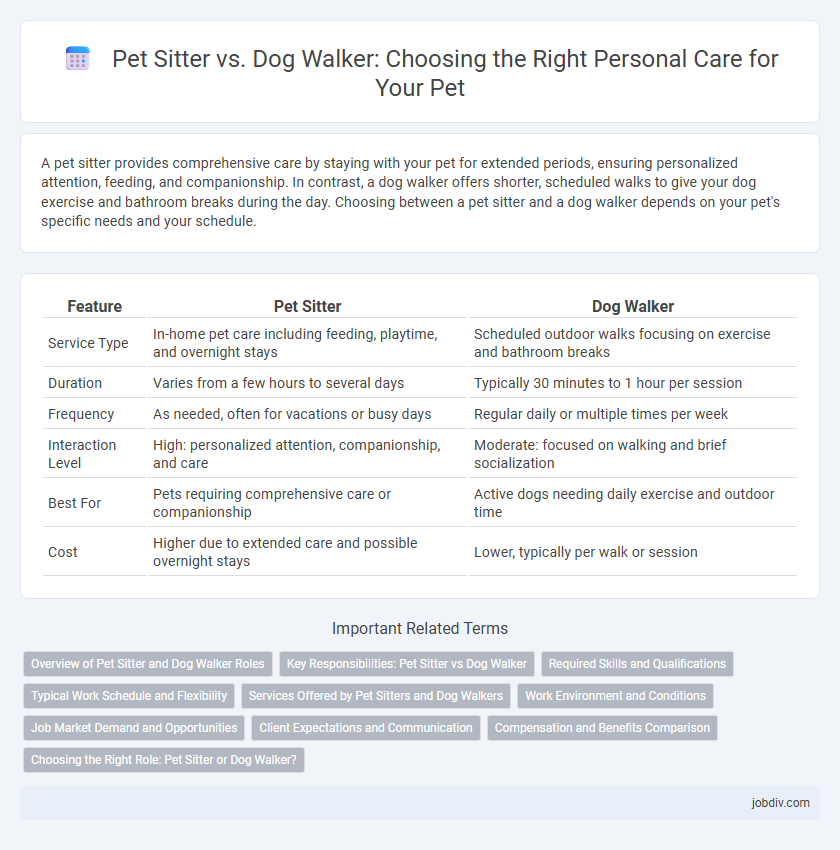A pet sitter provides comprehensive care by staying with your pet for extended periods, ensuring personalized attention, feeding, and companionship. In contrast, a dog walker offers shorter, scheduled walks to give your dog exercise and bathroom breaks during the day. Choosing between a pet sitter and a dog walker depends on your pet's specific needs and your schedule.
Table of Comparison
| Feature | Pet Sitter | Dog Walker |
|---|---|---|
| Service Type | In-home pet care including feeding, playtime, and overnight stays | Scheduled outdoor walks focusing on exercise and bathroom breaks |
| Duration | Varies from a few hours to several days | Typically 30 minutes to 1 hour per session |
| Frequency | As needed, often for vacations or busy days | Regular daily or multiple times per week |
| Interaction Level | High: personalized attention, companionship, and care | Moderate: focused on walking and brief socialization |
| Best For | Pets requiring comprehensive care or companionship | Active dogs needing daily exercise and outdoor time |
| Cost | Higher due to extended care and possible overnight stays | Lower, typically per walk or session |
Overview of Pet Sitter and Dog Walker Roles
Pet sitters provide comprehensive care, including feeding, administering medication, and overnight supervision, ensuring pets receive consistent attention in their home environment. Dog walkers focus primarily on exercise and outdoor activities, offering scheduled walks that cater to a pet's physical and mental stimulation needs. Both roles contribute to pet well-being but differ in scope and duration of care.
Key Responsibilities: Pet Sitter vs Dog Walker
Pet sitters provide comprehensive care by feeding, administering medication, cleaning, and offering companionship during the pet owner's absence, ensuring the pet's overall well-being in a home environment. Dog walkers focus primarily on exercising and socializing dogs through regular outdoor walks, which promote physical health and mental stimulation. Both roles require reliability and trustworthiness, but pet sitters often handle extended care, while dog walkers typically engage pets for shorter, scheduled periods.
Required Skills and Qualifications
Pet sitters must have strong observational skills and be knowledgeable about pet health to manage feeding, medication, and behavioral changes effectively. Dog walkers require high physical stamina, excellent knowledge of canine behavior, and the ability to handle multiple dogs safely during outdoor activities. Both roles benefit from certifications in pet CPR and first aid, as well as experience in animal care and client communication.
Typical Work Schedule and Flexibility
Pet sitters often maintain flexible schedules, providing care throughout the day or overnight, accommodating extended periods when owners are away. Dog walkers generally have more structured, shorter time frames, usually taking dogs out for walks during peak times such as early mornings, lunch breaks, or evenings. The flexibility of pet sitting suits long-term pet care needs, while dog walking offers consistent, daily exercise at predictable times.
Services Offered by Pet Sitters and Dog Walkers
Pet sitters provide comprehensive care including feeding, administering medication, and companionship during extended periods at a pet's home, ensuring personalized attention and monitoring. Dog walkers primarily focus on timed exercise sessions, offering socialization and physical activity essential for a dog's health and behavior. Both services complement each other by addressing different aspects of pet care, from routine exercise to continuous supervision.
Work Environment and Conditions
Pet sitters typically work in the pet owner's home, providing a personalized and calm environment tailored to the pet's needs, often for extended periods. Dog walkers operate outdoors, facing variable weather conditions and managing multiple dogs on scheduled routes, requiring physical stamina and time flexibility. Both roles demand responsibility and affection but differ significantly in daily work settings and environmental challenges.
Job Market Demand and Opportunities
The job market demand for pet sitters has surged as more pet owners seek personalized, in-home care, creating abundant opportunities in residential areas and vacation seasons. Dog walking remains a consistently strong niche, especially in urban environments where busy lifestyles drive daily exercise needs for pets. Both professions offer flexible schedules, but pet sitting often commands higher rates due to extended care requirements and overnight stays.
Client Expectations and Communication
Clients expect pet sitters to provide comprehensive care, including feeding, playtime, and overnight supervision, ensuring pets feel secure and comfortable. Dog walkers primarily focus on exercise and outdoor activities, requiring clear communication about walk duration, pet behavior, and any health restrictions. Effective communication channels, such as daily updates and real-time photos, help build trust and align services with client needs.
Compensation and Benefits Comparison
Pet sitters typically earn higher hourly rates than dog walkers due to offering extended care, often ranging from $25 to $75 per visit, while dog walkers usually charge $15 to $30 per walk. Benefits for pet sitters can include overnight stays and personalized attention, providing more comprehensive care and added income opportunities. Dog walkers benefit from a consistent schedule and multiple daily clients but generally receive lower pay and fewer perks compared to pet sitters.
Choosing the Right Role: Pet Sitter or Dog Walker?
Choosing the right role between a pet sitter and dog walker depends on the pet's needs and owner's schedule. Pet sitters provide comprehensive care, including feeding, companionship, and overnight stays, ideal for extended absences. Dog walkers focus on exercise and short-term engagement, perfect for busy owners needing regular outdoor activity for their dogs.
Pet Sitter vs Dog Walker Infographic

 jobdiv.com
jobdiv.com